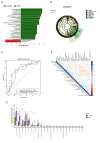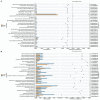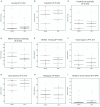Preoperative Status of Gut Microbiota Predicts Postoperative Delirium in Patients With Gastric Cancer
- PMID: 35308872
- PMCID: PMC8929925
- DOI: 10.3389/fpsyt.2022.852269
Preoperative Status of Gut Microbiota Predicts Postoperative Delirium in Patients With Gastric Cancer
Abstract
Introduction: Post-operative delirium (POD) is a serious complication which occurs after surgery, especially in the elderly undergoing abdominal surgery. Increasing evidence has revealed an association between the gut microbiota and psychological disorders involving the "brain-gut" axis. However, the association between the pathogenesis of POD after abdominal surgery in aging and composition of the gut microbiota remains unclear.
Methods: Forty patients (≥65 years old) who underwent abdominal surgery were included in the study. Twenty patients had POD, whereas 20 patients did not. POD was diagnosed and assessed using the confusion assessment method (CAM) during the postoperative period. Total DNA fractions were extracted from all fecal samples of patients. 16S rRNA sequencing was performed to determine the composition of the gut microbiota. The quality of the samples was determined by calculating the α- and β-diversities.
Results: The α- and β-diversities indicated that the samples were eligible for detection and comparison. We observed multiple differentially abundant bacteria in patients with and without POD. Generally, Proteobacteria, Enterbacteriaceae, Escherichia shigella, Klebsiella, Ruminococcus, Roseburia, Blautia, Holdemanella, Anaerostipes, Burkholderiaceae, Peptococcus, Lactobacillus, and Dorea were abundant in the POD cohort, whereas Streptococcus equinus and Blautia hominis were abundant in the control cohort. The results of receiver operating characteristic (ROC) curve analysis showed that the area under the curve (AUC) of Escherichia shigella was 0.75. Phenotype prediction showed that the gut microbiota may influence POD by altering the tolerance to oxidative stress.
Conclusion: There were significant associations between the pathogenesis of POD and composition of the gut microbiota. Escherichia shigella are promising diagnostic bacterial species for predicting POD onset after abdominal surgery in elderly people.
Clinical trial registration: http://www.chictr.org.cn/index.aspx, Chinese Clinical Trial Registry ChiCTR200030131.
Keywords: Shigella; aging; gut microbiota; post-operative delirium; prediction; surgery.
Copyright © 2022 Liu, Cheng, Xu, Fang, Ye, Wang and Liu.
Conflict of interest statement
The authors declare that the research was conducted in the absence of any commercial or financial relationships that could be construed as a potential conflict of interest.
Figures





Similar articles
-
Alterations in the gut microbiome and metabolome in elderly patients with postoperative delirium: A prospective nested case-control study.J Clin Anesth. 2025 Apr;103:111833. doi: 10.1016/j.jclinane.2025.111833. Epub 2025 Apr 13. J Clin Anesth. 2025. PMID: 40228374
-
Mechanical Bowel Preparation Is a Risk Factor for Postoperative Delirium as It Alters the Gut Microbiota Composition: A Prospective Randomized Single-Center Study.Front Aging Neurosci. 2022 Apr 4;14:847610. doi: 10.3389/fnagi.2022.847610. eCollection 2022. Front Aging Neurosci. 2022. PMID: 35444528 Free PMC article.
-
Abnormal composition of gut microbiota contributes to delirium-like behaviors after abdominal surgery in mice.CNS Neurosci Ther. 2019 Jun;25(6):685-696. doi: 10.1111/cns.13103. Epub 2019 Jan 24. CNS Neurosci Ther. 2019. PMID: 30680947 Free PMC article.
-
Postoperative delirium after cardiac surgery associated with perioperative gut microbiota dysbiosis: Evidence from human and antibiotic-treated mouse model.Anaesth Crit Care Pain Med. 2025 Apr;44(2):101484. doi: 10.1016/j.accpm.2025.101484. Epub 2025 Jan 23. Anaesth Crit Care Pain Med. 2025. PMID: 39862968
-
The Role of Gut Microbiota-Gut-Brain Axis in Perioperative Neurocognitive Dysfunction.Front Pharmacol. 2022 Jun 14;13:879745. doi: 10.3389/fphar.2022.879745. eCollection 2022. Front Pharmacol. 2022. PMID: 35774608 Free PMC article. Review.
Cited by
-
The association between gut microbiota and postoperative delirium in patients.Res Sq [Preprint]. 2023 Jan 23:rs.3.rs-2456664. doi: 10.21203/rs.3.rs-2456664/v1. Res Sq. 2023. Update in: Transl Psychiatry. 2023 May 9;13(1):156. doi: 10.1038/s41398-023-02450-1. PMID: 36747650 Free PMC article. Updated. Preprint.
-
Effect of Helicobacter pylori-induced gastric cancer on gastrointestinal microbiota: a narrative review.Front Oncol. 2025 Jan 10;14:1495596. doi: 10.3389/fonc.2024.1495596. eCollection 2024. Front Oncol. 2025. PMID: 39868371 Free PMC article. Review.
-
Clinical biomarkers of perioperative neurocognitive disorder: initiation and recommendation.Sci China Life Sci. 2025 Jul;68(7):1912-1940. doi: 10.1007/s11427-024-2797-x. Epub 2025 Jan 22. Sci China Life Sci. 2025. PMID: 39918707 Review.
-
The gut microbiota regulates the depressive-type behaviors and inflammatory processes after severe burn injuries in mice.Heliyon. 2024 Feb 10;10(4):e25617. doi: 10.1016/j.heliyon.2024.e25617. eCollection 2024 Feb 29. Heliyon. 2024. PMID: 38380023 Free PMC article.
-
Response: Commentary: Preoperative status of gut microbiota predicts postoperative delirium in patients with gastric cancer.Front Psychiatry. 2022 Sep 9;13:991290. doi: 10.3389/fpsyt.2022.991290. eCollection 2022. Front Psychiatry. 2022. PMID: 36159916 Free PMC article. No abstract available.
References
LinkOut - more resources
Full Text Sources

